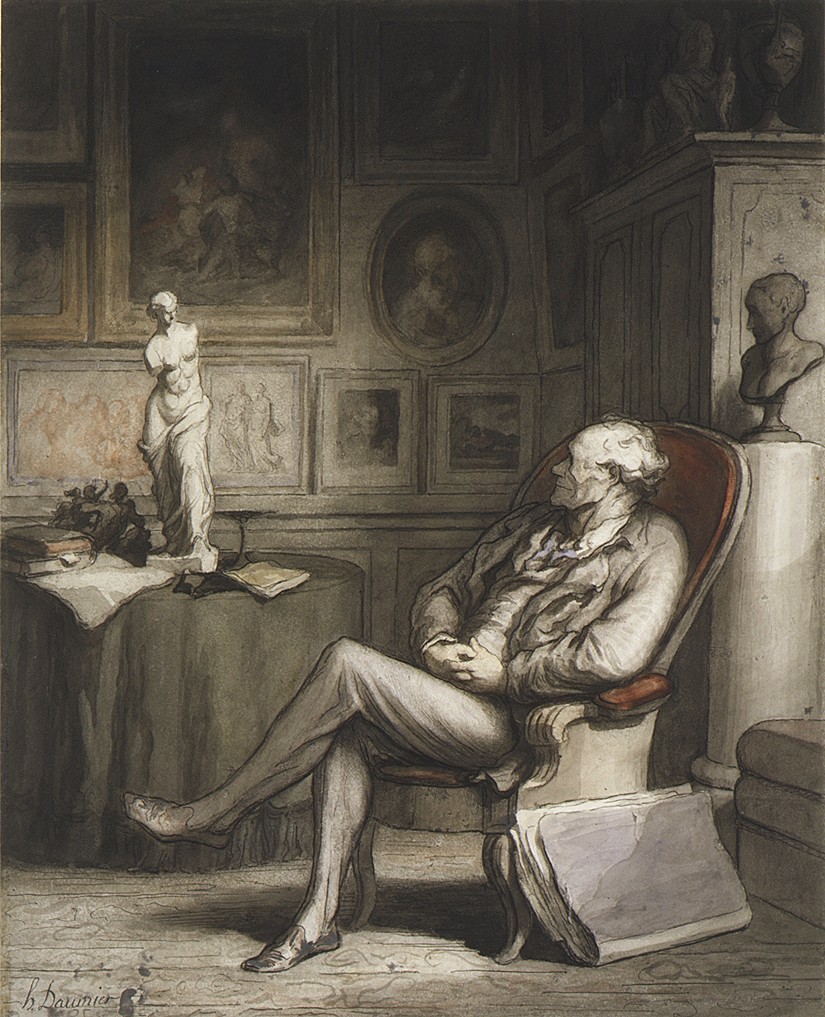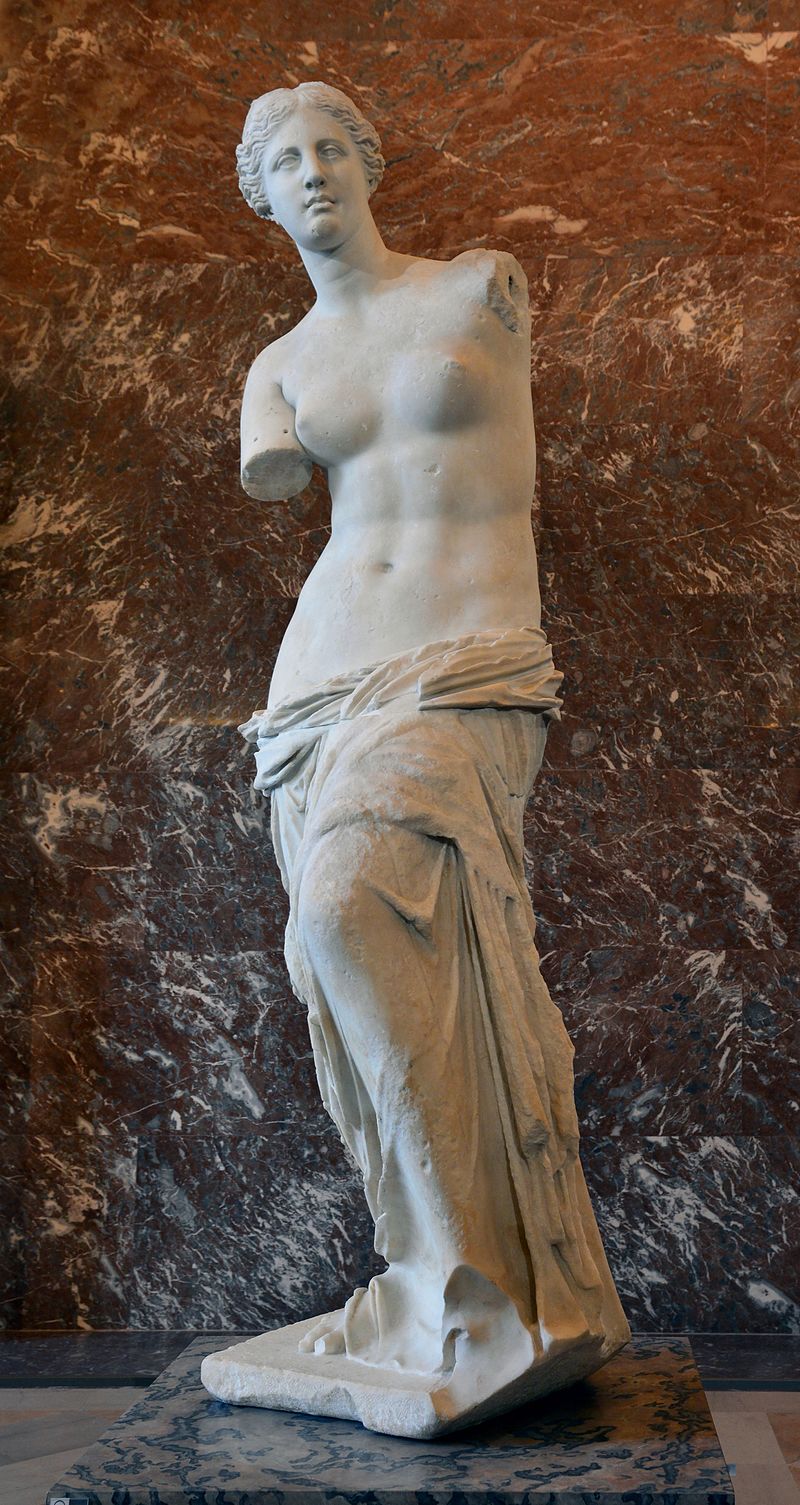In terms of art history, the Classical Period of Art was Created During the Eras of Ancient Greece and Ancient Rome.

Marble statue of Aphrodite
1st or 2nd century A.D.
Roman – Copy of a Greek statue of the 3rd or 2nd century B.C.
“The goddess of love is shown as though surprised at her bath. Originally, her arms reached forward to shield her breasts and pubis in a gesture that both concealed and accentuated her sexuality.
“Statues of Aphrodite in the nude proliferated during the Hellenistic period. All were inspired to some degree by the Aphrodite of Knidos, created in the fourth century B.C. by the famous Greek sculptor Praxiteles. That statue, the first major Greek work to show the goddess nude, was celebrated throughout antiquity. This work has the same gesture of modesty and is similar to another Roman copy, the so-called Medici Venus, which has stood in the Tribuna of the Uffizi Gallery in Florence since 1688.” The Met: https://www.metmuseum.org/art/collection/search/254697
The sculptures of Aphrodite are part of the basis for a Classical Ideal which has resurfaced several times since the era of Ancient Greece.

The Birth of Venus – Painted by Sandro Botticelli between about 1484 and 1486.
The figure for the Botticelli Venus [in Ancient Greek Mythology, her name was Aphrodite], is proportional to that of the sculpture of Aphrodite, first created in Ancient Greece.
Interest in the Classical Ideal increased even more during the 18th Century, with the discovery of the ancient city of Pompeii.

The Connoisseur
ca. 1860–65
Honoré Daumier French
Notice that “The Connoiseur” is studying the Classic Ideal.
“When, in 1860, Daumier was temporarily let go by his primary employer—the popular magazine that published his lithographs, Le Charivari—he began to produce highly finished watercolors such as this one to appeal to a burgeoning market of bourgeois collectors. Throughout his career, he often treated the theme of art spectators and enthusiasts. Here, he portrayed an exemplary connoisseur reclining in an armchair and contemplating his surrounding collection. The object of his gaze is a tabletop replica of the Venus de Milo, the monumental Greek marble that came to symbolize the beauty of Antique art upon its installation in the Musée du Louvre in 1821. This watercolor was included in Daumier’s only one-man exhibition during his lifetime, held at the Durand-Ruel Gallery in 1878.” The Met: https://www.metmuseum.org/art/collection/search/333915

The Venus di Milo – Created between 150 – 125 B. C. The Louvre
It is believed that The Venus di Milo was also modeled after the ancient sculpture of Aphrodite.
Nicolas Poussin, Et in Arcadia Ego, 1637–38, oil on canvas, 87 x 120 cm (Musée du Louvre, Paris, photo: Alonso de Mendoza)
“In opposition to the frivolous sensuality of Rococo painters like Jean-Honoré Fragonard and François Boucher, the Neoclassicists looked back to the French painter Nicolas Poussin for their inspiration (Poussin’s work exemplifies the interest in classicism in French art of the seventeenth century). The decision to promote “Poussiniste” painting became an ethical consideration—they believed that strong drawing was rational, therefore morally better. They believed that art should be cerebral, not sensual.
“The Neoclassicists, such as Jacques-Louis David (pronounced Da-VEED), preferred the well-delineated form—clear drawing and modeling (shading). Drawing was considered more important than painting. The Neoclassical surface had to look perfectly smooth—no evidence of brush strokes should be discernible to the naked eye.
“Jacques-Louis David, Oath of the Horatii, 1784, oil on canvas, 3.3 x 4.25 m, painted in Rome, exhibited at the salon of 1785 (Musée du Louvre; photo: Steven Zucker, CC BY-NC-SA 2.0)
Jacques-Louis David, Oath of the Horatii, 1784, oil on canvas, 3.3 x 4.25 m, painted in Rome, exhibited at the salon of 1785 (Musée du Louvre; photo: Steven Zucker, CC BY-NC-SA 2.0)
Jacques-Louis David, Oath of the Horatii, 1784, oil on canvas, 3.3 x 4.25 m, painted in Rome, exhibited at the salon of 1785 (Musée du Louvre; photo: Steven Zucker, CC BY-NC-SA 2.0)
France was on the brink of its first revolution in 1789, and the Neoclassicists wanted to express a rationality and seriousness that was fitting for their times. Artists like David supported the rebels through art that asked for clear-headed thinking, self-sacrifice to the State (as in Oath of the Horatii) and an austerity reminiscent of Republican Rome.
Neoclassicism was a child of the Age of Reason (the Enlightenment), when philosophers believed that we would be able to control our destinies by learning from and following the laws of nature (the United States was founded on Enlightenment philosophy). Scientific inquiry attracted more attention. Therefore, Neoclassicism continued the connection to the classical tradition because it signified moderation and rational thinking but in a new and more politically-charged spirit (“neo” means “new,” or in the case of art, an existing style reiterated with a new twist.)
Neoclassicism is characterized by clarity of form, sober colors, shallow space, strong horizontal and verticals that render that subject matter timeless (instead of temporal as in the dynamic Baroque works), and classical subject matter (or classicizing contemporary subject matter).